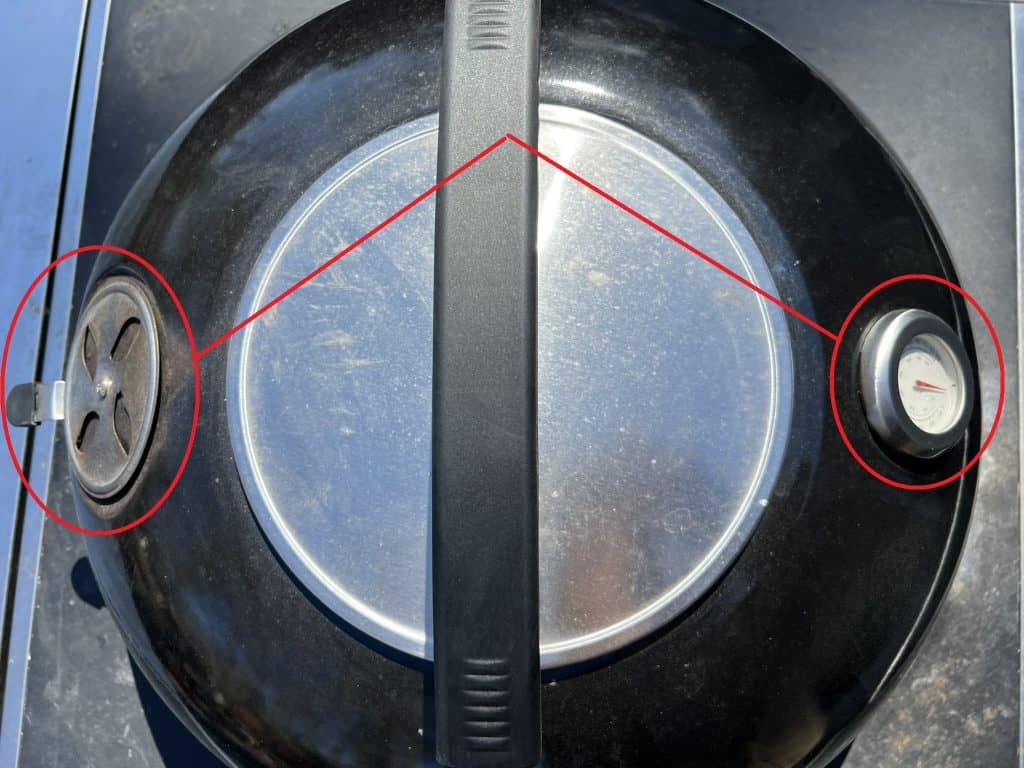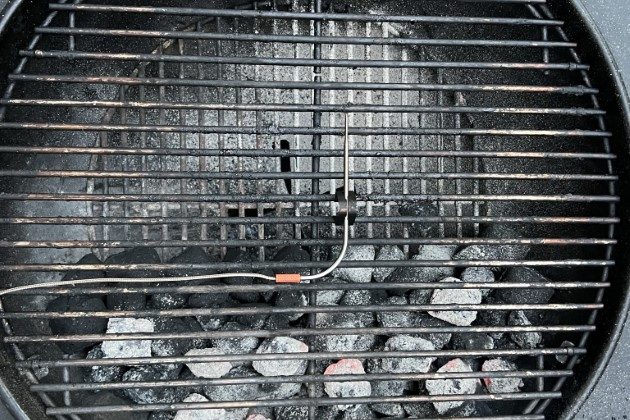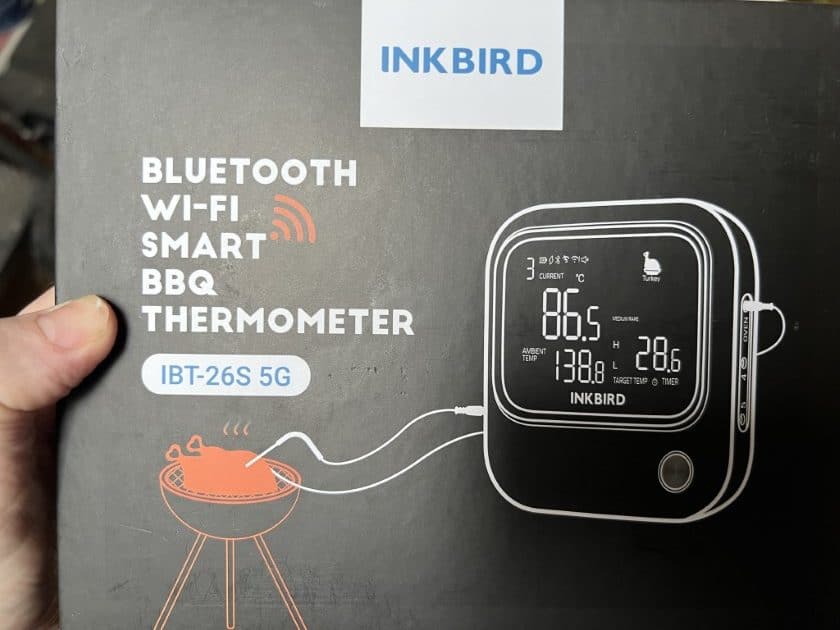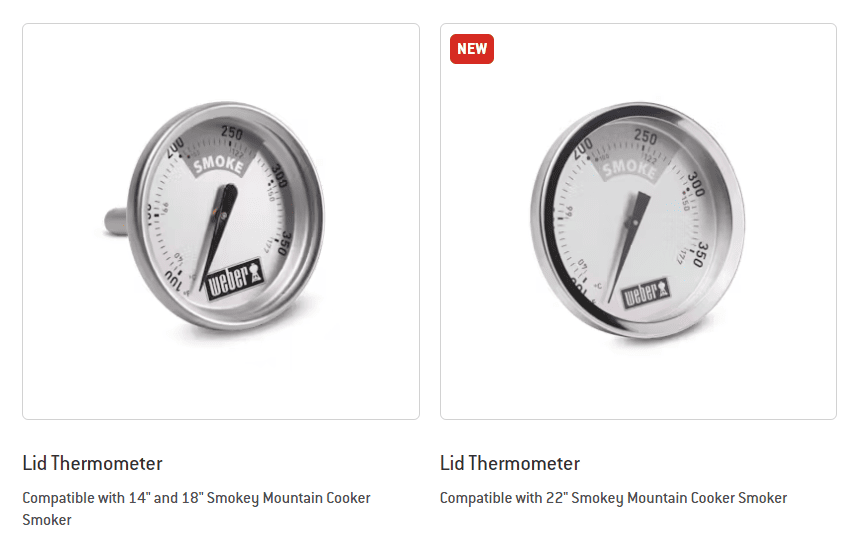Issues With the Weber Kettle Grill Thermometer Lid Design
Imagine the sizzle, the aroma, the sheer magic of a perfectly grilled steak. Now, picture biting into one that’s disappointingly over or undercooked. Annoying, right?
Most BBQ enthusiasts have been there, including me. I remember a summer evening when I was sure I’d nailed the timings and temperatures. But alas, my BBQ was less wow and more meh.
The culprit? The Weber Kettle Grill thermometer placement in the lid.
In This Article
- What is the Problem with Weber’s Lid Thermometer?
- The Crucial Role of Thermometer Placement
- The Predicament: Weber Kettle Grill Lid Thermometer Placement
- The Best Solution: Wireless Thermometer at Grill Level
- The Best Option: 5Ghz Wi-Fi Wireless Thermometers
- Fixing the Thermometer for the Weber Kettle
- Solutions for Accurate Temperature Monitoring on a Weber Kettle Grill
- Frequently Asked Questions

What is the Problem with Weber’s Lid Thermometer?
Positioned opposite the vent and close to the flames, it’s not always the best judge of the true indirect cooking temperature. It reads the temperature of the hottest air that rises, rather than the crucial grilling zone where your food cooks.
Join me as we dive deep into this design conundrum, and discover ways to ensure your grilling remains on point.
The Crucial Role of Thermometer Placement
Understanding where exactly your thermometer sits might seem like a minute detail, but in the world of BBQ it’s monumental!
Thermometers gauge the temperature, guiding us in our culinary quest for perfection. But here’s the kicker: if it’s in the wrong place, your readings can be skewed.
Recall a time you tried following a new recipe. You’re pumped, you’re ready, but the dish doesn’t quite turn out as expected.
Its placement directly influences the precision of your cooking, and believe me, a few degrees can make a world of difference!

The Predicament: Weber Kettle Grill Lid Thermometer Placement
Ever notice how the Weber Kettle Grill’s thermometer is typically placed above the direct fire? It’s like trying to read a book with a flashlight that’s too close.
The heat from the direct fire can greatly influence the thermometer’s readings, and not in a good way.
You might think you’re grilling at a moderate temperature, but in reality, you could be way off the mark on the indirect side.
The thermometer’s placement can give you an inaccurate portrayal of the cooler, indirect zone. And if you’re aiming for slow cooked smoky perfection, this little design quirk might just throw a wrench in your plans.

The Best Solution: Wireless Thermometer at Grill Level
Here’s where the game truly changes: wireless thermometers placed right where the action is, at grill level.
Think about it, wouldn’t you want a temperature reading from the very spot your meats and veggies lay, sizzling away?
The lid’s temperature can be a deceptive ruse, but the grill level’s temperature is the heart of the matter.
Now, imagine you’re in a two story house. The upstairs might be sweltering hot, while the ground floor remains pleasantly cool.
The Weber Kettle Grill works similarly. The temperature at the lid isn’t always indicative of what’s happening at the grill level, especially where your meat is.
This is why a Wi-Fi wireless thermometer at the grill level is a game changer.
I made the switch after a particularly frustrating BBQ session when my meticulously marinated chicken came out unevenly cooked. The next time, armed with my trusty wireless thermometer, every bite was succulent perfection.
Truly, for anyone serious about grilling, a wireless meat thermometer is the way to go.

The Best Option: 5Ghz Wi-Fi Wireless Thermometers
With the rise of smart homes and cutting-edge technology, the realm of BBQ hasn’t been left behind.
Wi-Fi wireless thermometers, especially those boasting 5Ghz connectivity, are revolutionizing our grilling game.
Let’s delve into why these modern marvels are becoming an essential tool for every grill master:
- Direct Monitoring, No Guesswork: With sensors right at the grill level, these thermometers offer a direct insight into your cooking process. Say goodbye to generalized temperature guesses and hello to pinpoint accuracy.
- 5Ghz Wi-Fi Compatibility: Today’s wireless thermometers are catching up with the fast paced world of 5Ghz. This ensures a smoother connection, faster data transfer, and an even easier setup process. Imagine syncing your thermometer to your modern Wi-Fi network in just a snap. It’s that simple!
- Perfect Fit with Weber Kettle Grills: These devices are designed with popular grills in mind. Whether you’re working with a classic Weber Kettle or another favorite, integrating a wireless thermometer is hassle free.
- Real-time Updates on the Go: Thanks to WiFi connectivity, you’re not just limited to your home Bluetooth range. You can keep tabs on your grill even if you step out for an errand. Your BBQ progress is literally at your fingertips, ensuring you’re always in the know.
During one of my BBQ sessions, I decided to try out a wireless thermometer. Connecting it to my home’s Wi-Fi was a breeze, and the real-time updates were impressively swift. As I relaxed indoors, I received prompt notifications, ensuring my steaks were grilled to perfection.
It felt like a futuristic BBQ experience, and honestly, I wouldn’t have it any other way.
Fixing the Thermometer for the Weber Kettle
Where Is the Ideal Placement for a Lid Thermometer?
Ever wonder where the sweet spot for a lid thermometer’s placement might be? The answer is right beside the vent!
Positioning the thermometer beside the vent gives a much truer representation of the temperature in the indirect cooking zone.
The Weber Kettle Grill allows the heat to circulate and escape. So, placing a thermometer next to it can capture a more accurate reading of the average grill temperature.

Solutions for Accurate Temperature Monitoring on a Weber Kettle Grill
Even for the most seasoned grillers, achieving that ideal temperature can be a bit of a dance.
However, with the right tools and tweaks, you can waltz your way to BBQ brilliance.
You have a couple of solutions that you can choose from:
- Add a Second Thermometer Beside the Vent: While the built in thermometer may have its quirks, you can always add a secondary one. Positioning it next to the vent can give you a more balanced reading of the grill’s overall temperature, ensuring your meats aren’t left in the cold, or the scorching heat.
- Embrace the Gold Standard – Wi-Fi Wireless Thermometers at the Grate Level: Remember that two story house analogy? Now imagine having a thermostat on both floors. A wireless thermometer at the grill level offers real time feedback, ensuring your food cooks just right. Whether you’re working with steaks, ribs, or even delicate fish, these thermometers can be your secret weapon.
I still fondly remember the first time I used a wireless thermometer. The convenience of monitoring the grill from my phone, without constantly lifting the lid, was a revelation.
And the end result? BBQ that was perfectly smoked!
Remember, lookin’ ain’t cookin’.
Frequently Asked Questions
Can I Add A Thermometer To My Weber Kettle Grill?
Yes, you can add an external thermometer to a Weber kettle grill for better temperature accuracy.
Where do you put the thermometer in a Weber kettle?
The thermometer should be positioned at grill level, where the meat is, for the most accurate reading.
Are Weber Kettle grill thermometers accurate?
No. While it provides a general indication, the built-in thermometer can sometimes read higher temperatures due to its position on the lid.
Is there a reason Weber put the thermometer opposite the vent?
I suspect this is because whoever designed the kettle did not use it for 2 zone cooking and smoking. Weber places the thermometer opposite the vent This is directly above the fire causing an inaccurate temperature reading.
Where is the Best Place to Install a Thermometer on a Weber Kettle Grill?
The best place is at grill level, near where the meat is positioned, for the most accurate temperature reading. If you want to add a second lid thermometer the best location is beside the vent.

